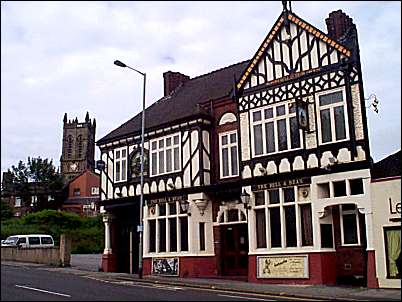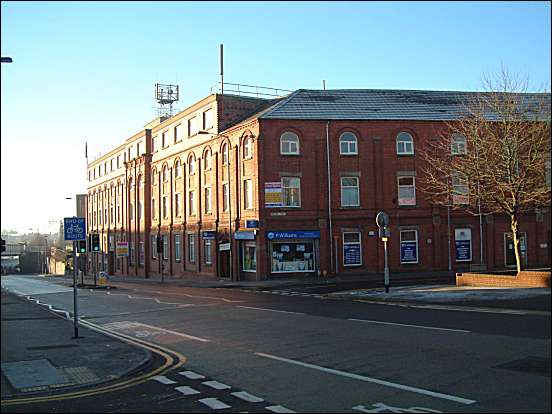|
Secular life in the Parish in the first
three decades of the 20th Century is very much a matter of record and
the personal memories of a few survivors from that era. Building
development continued, although not at the same furious rate as in the
preceding decades. Some large imposing houses were built on or near the
corners of Victoria Road near the parks, a Congregational Church was
built on Boughey Road / Cauldon Road below the park entrance, and a
Baptist Church in Cauldon Road near Stoke Road. Weddell's ice factory
operated at the Stoke Road end of Seaford Street, with Boyce Adams
general grocery shop on the corner; Boyce Adams himself is recorded as
living at Crescent Villa in Cemetery Road. There was a chain of such
shops throughout the area; Princes was another name in that field.
As a small boy I believed the shops were
called Boy Sadams, and wondered who the "Boy" was. I was also
often sent to Snow Hill, below St Mark's Shelton, to pay the florist's
bill at Lewis and Sprosons, which by the same childish logic was "Lewison
Sprosons". Incidentally the shop, next door to the Bell and Bear
Inn is still trading.
The Bell and Bear although off our patch,
is a fine Edwardian pile, the latest of several to have stood on that
site. The main Hanley road originally ran to the side of the florists
shop, that portion being known as Cleveland Place, continuing
round the back to emerge between Swynnerton's corner shop and Shelton
Church. The inn faced the old road, but when it became a Turnpike and
all the "kinks" were straightened out, the old building was demolished
and rebuilt to face the newly re-aligned road known as Snow Hill, the
old road now being named Cutts Street. The present building dates from
1902.

The Bear and Bell -
Shelton
Snow Hill
In the background, on the left St. Mark's church tower is visible.
Back in St Jude's a new school had been
built on land acquired from the estate of Sir Thomas Fenton-Boughey,
bounded by Cauldon Road, Ford Street, Beresford Street and Victoria
Road, and was named Cauldon Road Elementary School, with Senior Boys at
the Ford Street end.
Between Leek Road and the river, on the
remnants of Trent Hay Farm, were allotment gardens and Hanley Sewage
Treatment Works (hidden behind a grassy bank). On Leek Road was a
corrugated-iron Mission and Sunday School, known as the Railway Mission.
At the top end of Victoria Road, once again just outside the Parish was
the new imposing red brick Drill Hall, home to the 1st (Volunteer)
Battalion of the North Staffordshire Regiment. The last remnants of
Shelton Farm had been turned into allotment gardens fronting Wellesley
Street, with an adjacent abattoir and holding field known as Mayer's
Field.

Sheep grazing at Shelton Farm.
c.1950-1952
Behind them is St. Marks Church tower which
can just be seen behind the Swynnerton Pottery, on the
right of the photograph. This semi-rural area is close
to Hanley town centre near Vale Place.
The church and pottery works is still there, the latter
minus its bottle ovens. The area in the foreground is
now covered by housing.
Staffordshire Past Track
© copyright, of The Potteries
Museum & Art Gallery
- used for private, research, education purposes - do
not reproduce for profit -
|
A large pottery manufactory was built on
Stoke Road near the Railway, by Grimwades, Royal Winton, (the old
Glebe-land name being used once more). A doctor's practice was
established in St Jude's, when Dr Southwell set up in the Villa at the
end of Queen Anne Street, (he performed a hysterectomy on Ann Dale in
1910 at home in Watford Street). A self-contained community had been
created with a population exceeding the whole Potteries district in the
middle of the 18th Century, only 170 years before.
There was however, something missing from St Jude's. There were no
public houses!

Grimwades, Winton House
There were Outdoor Beer Shops or
Off-Licences; Feazy's in later years, at the corner of Seaford Street/
Victoria Road, MacMillan's at the corner of Boughey Road and Cauldon
Road and another at the corner of Ashford Street/ Guildford Street, but
the nearest pubs or bars were at the Railway Station, the North Stafford
Hotel, The Roebuck, The Terrace in Leek Road or the Norfolk in Norfolk
Street beyond the canal near Howard Place. The reason for this may have
been a restriction placed on the land at the time of sale, but the
history is obscure. This was to remain unchanged until the late 1950's.

Norfolk Inn - Norfolk
Street
As a result of the Municipal Corporations
Act some decades before, Stoke was now a modern Borough as were Burslem
and Longton. Tunstall and Fenton being created Urban Districts; Hanley
having the bulk of the population was a County Borough. All this was to
change however, when an Act of Parliament in 1910 created the County
Borough of Stoke-on-Trent out of all the constituent Councils with a
population in excess of 200,000. A proud day for the federalists - for
it was known as Federation - but a matter of regret for the
traditionalists. Stoke was to become the administrative centre, with
Hanley being the business and commercial centre.( Stoke-on-Trent was
elevated to City status by King George V in 1925).
The outbreak of the Great War in 1914 put a
halt to all but essential building. Stoke Railway Station in St Jude's
Parish was the principal station of the area, and must have seen many
thousands of men on their way to join their regiments. It should not be
forgotten however, that there were also railway stations in towns and
villages all over North Staffordshire. The coal and steel industries
were working to capacity.
Frank Dale, the eldest of the Dale children
joined the Kings Royal Rifles, while Leonard the eldest Alcock boy,
joined the North Staffordshire Regiment and later transferred to the
Royal Flying Corps. Both served in France, and when they could be
persuaded to speak about their experiences did so so in a self-
deprecating, slightly self-mocking way, and could always be prevailed on
to sing "It's a Long Way to Tipperary" or a sanitised version of
"Mademoiselle from Armenteers". Edgar the younger of the Alcock boys,
went with his father on a visit to London in 1916 and was terrified to
see German Zeppelin airships fly over-head dropping bombs. He began his
working career at the Potteries Electric Traction tram company in 1920 -
and he from a railway family too!. Leonard went to London after the War
and worked in the Goods and Parcels Dept. at Kings Cross / St Pancras
until he retired.
He never married, but was a frequent visitor to the family home. Frank
Dale worked for the BBC in Stoke after the War, and then had a series of
managerial jobs in the pottery industry.
In charting the progress of these two
families during the "between the wars" period, it is probably a fair
representation of the lives of many people in the area, indeed
throughout the land. Far from wealthy, they would never have considered
themselves poor or needy, but were fiercely independent, respectable and
respected. For the girls in those days, the expectation was a
run-of-the- mill job after leaving school, with marriage not too long
afterwards. Woolworths for the oldest and youngest Dale girls, Esme and
Vera, with Lucy in the middle, going to a bakery. Contrary to that
expectation, but not uncommon amongst families of the period, Esme never
married but stayed at home with her widowed mother. The eldest Alcock
girl Hetty Louise married a railwayman and moved round the country to
all points between Kings Lynn and Dagenham with her Stationmaster
husband. Irene the youngest took a clerical position before she too
married in the 1930's. In 1934 Edgar Wilne Alcock and Vera Dale were
married at St Jude's Church, and after two years in Hartshill came to
live in Seaford Street. Lucy Dale married George William Bates, a
carpenter and joiner from the Tontine Inn, Hanley, and they settled in
Boughey Road.
In the 1920's and 30's
building in St
Jude's continued. Cauldon Road was completed on the north side, although
the style moved away from the traditional terraces, surburban
semi-detached houses being in vogue, with a number of linked houses in
blocks of four, in the modern style. More up-market were the new houses
in Park Avenue, Avenue Road and Ridgway Road facing the parks. Small by
today's standards, but then highly desirable; a Christian Science Church
was built in Avenue Road. After the Great War an armoured tank was
exhibited for some years on a triangular piece of land at the top end of
Victoria Road above the park. The Cricket Ground near Station Road was
bounded on its Victoria Road frontage by high advertisement hoardings,
and an old railway carriage was installed as a Pavilion. A row of Co-op
shops was built on Victoria Road opposite St Jude's Church. The North
Staffordshire Technical College with its interesting sculpted frieze
above the entrance had been built at the bottom end of Victoria
Road, and round the corner in Station Road was the imposing
Federation House, home to several ceramics related organisations.

The former North
Staffordshire Technical College
Victoria (now College) Road

in Station Road was the
imposing Federation House
The Potteries Electric Traction Co. Ltd
became the Potteries Motor Traction in 1926, a motor bus service now
operating over a wider area, no longer restricted by tram lines. Leek
Road carried buses to Bucknall and beyond, Stoke Road lay on the main
central route that ran the length of the City, while Victoria Road was
on the route of the Riley Arms Circular. This was a circuitous route
which covered Hartshill, Stoke, Shelton, Hanley, Sneyd Green,
Smallthorne and High Lane, on which stood the eponymous Riley Arms
Public House. Local people were known to take the round trip, just for
the fun of it. Doctors Frank and James Yates took over the practice in
Queen Anne Street, and were known by all as Dr Frank and Dr James.
Although it was an era of financial
uncertainty, it was also an era of increased leisure, modest by modern
standards and far more energetic. Walks to Trentham along the "New Road"
or along the canal side to Barlaston, shopping in Stoke, better still
Hanley, or even more exotic to Newcastle, still separate and aloof, with
a slightly up-market atmosphere; dances at the King's Hall in Stoke,
numerous cinemas within easy reach, outings to the recently established
Repertory Theatre, outdoor events in Hanley Park and social activities
at St Jude's. It is true if somewhat clichéd, to observe that soon this
was to end as war approached.
  
next: boyhood
previous: parish life
|
![]()
![]()
![]()